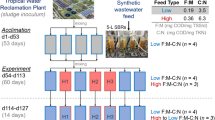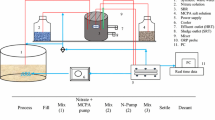Abstract
Nitrification—microbial oxidation of ammonia to nitrate—is sensitive to an array of inhibitors. Currently, little is known regarding the ecological processes that enable adaptation to inhibitors and recovery of nitrification. This study evaluated inhibition and recovery of nitrification in batch cultures of activated sludge incubated with different levels of nickel (Ni), a model inhibitor. Incubation with 1 mg/L of added Ni did not adversely affect nitrification, and little inhibition occurred at 5 and 10 mg/L Ni. Incubation with 50 mg/L Ni resulted in significant inhibition, decreased amoA transcript abundance, and delayed recovery of nitrification until amoA transcript abundance rebounded after 24 h. For this dosage, recovery of nitrification occurred without a significant change in ammonia-oxidizing bacteria (AOB) community structure. By contrast, incubation with 150 mg/L of added Ni strongly inhibited nitrification and delayed recovery until a shift in AOB community structure occurred after ∼6 weeks of incubation. The results indicate that inhibitor-resistant nitrifying cultures can be obtained from long-term batch incubations of decaying activated sludge incubated with high levels of added inhibitor.





Similar content being viewed by others
References
Anderson M (2001) A new method for non-parametric multivariate analysis of variance. Austral Ecology 26:32–46
Aoi Y, Shiramasa Y, Tsuneda S, Hirata A, Kitayama A, Nagamune T (2002) Real-time monitoring of ammonia-oxidizing activity in a nitrifying biofilm by amoA mRNA analysis. Water Sci Technol 46:439–442
Araki N, Yamaguchi T, Yamazaki S, Harada H (2004) Quantification of amoA gene abundance and their amoA mRNA levels in activated sludge by real-time PCR. Water Sci Technol 50:1–8
Arvin E, Dyreborg S, Menck C, Olsen J (1994) A mini-nitrification test for toxicity screening, Minntox. Water Res 28:2029–2031
Avrahami S, Bohannan BJ (2007) Response of Nitrosospira sp. strain AF-like ammonia oxidizers to changes in temperature, soil moisture content, and fertilizer concentration. Appl Environ Microbiol 73:1166–1173
Bollmann A, Bar-Gilissen MJ, Laanbroek HJ (2002) Growth at low ammonium concentrations and starvation response as potential factors involved in niche differentiation among ammonia-oxidizing bacteria. Appl Environ Microbiol 68:4751–4757
Brandt KK, Hesselsoe M, Roslev P, Henriksen K, Sorensen J (2001) Toxic effects of linear alkylbenzene sulfonate on metabolic activity, growth rate, and microcolony formation of Nitrosomonas and Nitrosospira strains. Appl Environ Microbiol 67:2489–2498
Curtis TP, Sloan WT (2006) Towards the design of diversity: stochastic models for community assembly in wastewater treatment plants. Water Sci Technol 54:227–236
Dunbar J, Ticknor LO, Kuske CR (2000) Assessment of microbial diversity in four southwestern United States soils by 16S rRNA gene terminal restriction fragment analysis. Appl Environ Microbiol 66:2943–2950
Ebie Y, Noda N, Miura H, Matsumura M, Tsuneda S, Hirata A, Inamori Y (2004) Comparative analysis of genetic diversity and expression of amoA in wastewater treatment processes. Appl Microbiol Biotechnol 64:740–744
Francis CA, Beman JM, Kuypers MM (2007) New processes and players in the nitrogen cycle: the microbial ecology of anaerobic and archaeal ammonia oxidation. ISME J 1:19–27
Gikas P (2008) Single and combined effects of nickel (Ni(II)) and cobalt (Co(II)) ions on activated sludge and on other aerobic microorganisms: a review. J Hazard Mater 159:187–203
Graham DW, Knapp CW, Van Vleck ES, Bloor K, Lane TB, Graham CE (2007) Experimental demonstration of chaotic instability in biological nitrification. ISME J 1:385–393
Grunditz C, Dalhammar G (2001) Development of nitrification inhibition assays using pure cultures of Nitrosomonas and Nitrobacter. Water Res 35:433–440
Hausinger RP, Zamble DB (2007) Microbial Physiology of Nickel and Cobalt. In Molecular Microbiology of Heavy Metals. Nies DH and Silver S (eds). Berlin: Springer-Verlag p.460
He JZ, Shen JP, Zhang LM, Zhu YG, Zheng YM, Xu MG, Di H (2007) Quantitative analyses of the abundance and composition of ammonia-oxidizing bacteria and ammonia-oxidizing archaea of a Chinese upland red soil under long-term fertilization practices. Environ Microbiol 9:2364–2374
Horz HP, Rotthauwe JH, Lukow T, Liesack W (2000) Identification of major subgroups of ammonia-oxidizing bacteria in environmental samples by T-RFLP analysis of amoA PCR products. J Microbiol Methods 39:197–204
Horz HP, Barbrook A, Field CB, Bohannan BJ (2004) Ammonia-oxidizing bacteria respond to multifactorial global change. Proc Natl Acad Sci U S A 101:15136–15141
Hu Z, Chandran K, Grasso D, Smets BF (2003) Impact of metal sorption and internalization on nitrification inhibition. Environ Sci Technol 37:728–734
Kelly RT 2nd, Henriques ID, Love NG (2004) Chemical inhibition of nitrification in activated sludge. Biotechnol Bioeng 85:683–694
Klotz MG, Arp DJ, Chain PS, El-Sheikh AF, Hauser LJ, Hommes NG, Larimer FW, Malfatti SA, Norton JM, Poret-Peterson AT, Vergez LM, Ward BB (2006) Complete genome sequence of the marine, chemolithoautotrophic, ammonia-oxidizing bacterium Nitrosococcus oceani ATCC 19707. Appl Environ Microbiol 72:6299–6315
McCaig AE, Phillips CJ, Stephen JR, Kowalchuk GA, Harvey SM, Herbert RA, Embley TM, Prosser JI (1999) Nitrogen cycling and community structure of proteobacterial beta-subgroup ammonia-oxidizing bacteria within polluted marine fish farm sediments. Appl Environ Microbiol 65:213–220
Mertens J, Broos K, Wakelin SA, Kowalchuk GA, Springael D, Smolders E (2009) Bacteria, not archaea, restore nitrification in a zinc-contaminated soil. ISME J 3:916–923
Mosier AC, Francis CA (2008) Relative abundance and diversity of ammonia-oxidizing archaea and bacteria in the San Francisco Bay estuary. Environ Microbiol 10:3002–3016
Nicol GW, Leininger S, Schleper C, Prosser JI (2008) The influence of soil pH on the diversity, abundance and transcriptional activity of ammonia oxidizing archaea and bacteria. Environ Microbiol 10:2966–2978
Norton JM, Alzerreca JJ, Suwa Y, Klotz MG (2002) Diversity of ammonia monooxygenase operon in autotrophic ammonia-oxidizing bacteria. Arch Microbiol 177:139–149
Norton JM, Klotz MG, Stein LY, Arp DJ, Bottomley PJ, Chain PS, Hauser LJ, Land ML, Larimer FW, Shin MW, Starkenburg SR (2008) Complete genome sequence of Nitrosospira multiformis, an ammonia-oxidizing bacterium from the soil environment. Appl Environ Microbiol 74:3559–3572
Purkhold U, Pommerening-Roser A, Juretschko S, Schmid MC, Koops HP, Wagner M (2000) Phylogeny of all recognized species of ammonia oxidiers based on comparative 16S rRNA and amoA sequence analysis: implications for molecular diversity surveys. Appl Environ Microbiol 66:5368–5382
Rittmann BE, McCarty PL (2001) Environmental Biotechnology: Principles and Applications. Boston: McGraw-Hill
Rotthauwe JH, Witzel KP, Liesack W (1997) The ammonia monooxygenase structural gene amoA as a functional marker: molecular fine-scale analysis of natural ammonia-oxidizing populations. Appl Environ Microbiol 63:4704–4712
Stein LY, Arp DJ, Berube PM, Chain PS, Hauser L, Jetten MS, Klotz MG, Larimer FW, Norton JM, Op den Camp HJ, Shin M, Wei X (2007) Whole-genome analysis of the ammonia-oxidizing bacterium, Nitrosomonas eutropha C91: implications for niche adaptation. Environ Microbiol 9:2993–3007
Stephen JR, Chang YJ, Macnaughton SJ, Kowalchuk GA, Leung KT, Flemming CA, White DC (1999) Effect of toxic metals on indigenous soil beta-subgroup proteobacterium ammonia oxidizer community structure and protection against toxicity by inoculated metal-resistant bacteria. Appl Environ Microbiol 65:95–101
Sujarittanonta S, Sherrard JH (1981) Activated sludge nickel toxicity studies. J Water Pollution Control Federation 53:1314–1322
Suwa Y, Sumino T, Noto K (1997) Phylogenetic relationships of activated sludge isolates of ammonia oxidizers with different sensitivities to ammonium sulfate. J Gen Appl Microbiol 43:373–379
Tamura K, Dudley J, Nei M, Kumar S (2007) MEGA4: Molecular Evolutionary Genetics Analysis (MEGA) software version 4.0. Mol Biol Evol 24:1596–1599
Vlaeminck SE, Geets J, Vervaeren H, Boon N, Verstraete W (2007) Reactivation of aerobic and anaerobic ammonium oxidizers in OLAND biomass after long-term storage. Appl Microbiol Biotechnol 74:1376–1384
Wells GF, Park HD, Yeung CH, Eggleston B, Francis CA, Criddle CS (2009) Ammonia-oxidizing communities in a highly aerated full-scale activated sludge bioreactor: betaproteobacterial dynamics and low relative abundance of Crenarchaea. Environ Microbiol 11:2310–2328
Acknowledgments
This work was supported in part by the Woods Institute for the Environment at Stanford, National Science Foundation SGER Grant CBET-0630092, and by the PARWQCP. C.H.Y. was supported by Hong Kong Alumni and the Gabilan Stanford Graduate Fellowship. We also thank George Wells for providing valuable comments on the manuscript.
Author information
Authors and Affiliations
Corresponding author
Additional information
Submission as a full research paper to Applied Microbiology and Biotechnology.
Electronic supplementary material
Below is the link to the electronic supplementary material.
ESM 1
(DOCX 35.6 kb)
Rights and permissions
About this article
Cite this article
Yeung, CH., Francis, C.A. & Criddle, C.S. Adaptation of nitrifying microbial biomass to nickel in batch incubations. Appl Microbiol Biotechnol 97, 847–857 (2013). https://doi.org/10.1007/s00253-012-3947-x
Received:
Revised:
Accepted:
Published:
Issue Date:
DOI: https://doi.org/10.1007/s00253-012-3947-x




